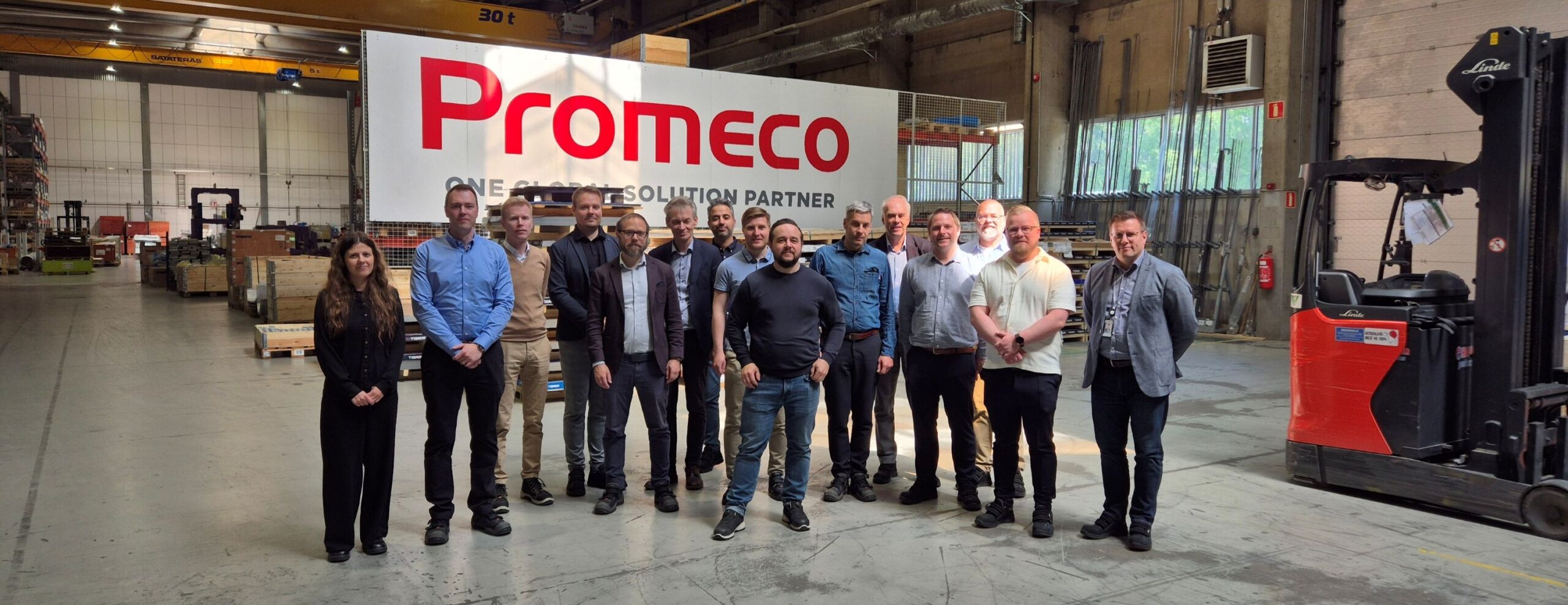14 August 2025
DIM partners visited Promeco’s factory in Vaasa
On June 12, 2025, the DIM partners convened at the Promeco factory in Vaasa to learn about Promeco’a ability to grow continuously by focusing on customers. This provided a natural basis for deep discussions on how value co-creation must be adapted in the present, dynamically evolving manufacturing sector. We also discussed the upcoming DIM activities for the second half of 2025. The event brought together participants from Business Finland, Konecranes, Mirka, Promeco, Synocus, Tampere University, and Wärtsilä.
The meeting was hosted by Lauri Kaminen, the technology director of Promeco who also chairs the DIM project’s steering committee. Lauri introduced Promeco and highlighted the company’s significant investments in new technologies, expanded production facilities, and increased personnel at its Vaasa unit. Heidi Hakala, QEHS director at Promeco, presented the company’s comprehensive sustainability development program, emphasizing Promeco’s commitment to sustainable practices.
Developing co-creation use cases
The core of the meeting revolved around the presentation and discussion of co-creation use cases prepared by the participating companies.
A key topic in all cases concerned the use of data generated in the manufacturing process. Mirka seeks possibilities for more efficient predictive maintenance through the use of data. Promeco wants to use sustainability-related data as a value-adding element to be offered to its customers. Konecranes sees potential in using operational data from its cranes to support its customers’ internal logistics. Wärtsilä, in turn, aims to increase supply chain agility and flexibility when developing green viable solutions. The use of data as part of the value proposition also raises the question of how products and platforms can support each other.
The DIM project members are all engaged in activities aiming at increasing their competitiveness in respect of digitalization and decarbonization. These topics can also be expected to receive continuous attention from Finnish policy makers as Finland continues to strive for global leadership in cleantech solutions. However, the business outlook has become much more difficult to predict due to the geopolitical turbulence we now face. This is expected to characterize the business landscape in the future and is forcing companies to be prepared for rapid changes if political conflicts will further escalate. It was agreed that customer focus is a relevant perspective in all scenarios. Finding new value-creating opportunities based on the ongoing changes is a strategy that has rewarded Promeco with significant new business this year.
Building springboards for innovation collaboration
During the 1990s, Nokia became a global telecom leader thanks to its innovation collaboration with the Finnish government, Tekes, and VTT to fulfill the mission of making Finland a global leader in mobile telecommunications. This was supported by local springboards in the capital region, Tampere, and Oulu which also provided fertile ground for startups and new types of innovation collaboration, e.g., related to the development of mobile games. The most successful companies formed their own firm-centric ecosystems based upon which they were able to scale their businesses internationally.
Another example of public-private innovation collaboration is the yacht building sector in Ostrobothnia supported by the Boat Technology Center in Pietarsaari, which was initiated at the turn of the millennium by Nautor, the Ostrobothnian Chamber of Commerce, and the City of Pietarsaari.
Integrating national and local activities is also recommended by the national industrial policy strategy, published in December 2024, in the form of new industrial hubs (teollisia keskittymiä) to generate growth from research, innovations, and international networks.
These examples suggest that missions, springboards, and firm-centric ecosystems should be integrated to accelerate sustainable growth. This is also the message offered by Mikko Kosonen and Timo Santalainen in their book Elinvoimaetu; improved public-private collaboration can drive economic growth and build viability advantage.
Orchestrators can engage ecosystem partners to be forerunners in innovation collaboration driving growth. Three types of ecosystem engagement are relevant:
- Mission ecosystems; fifteen years ago, Tekes’s EVE program was a rather successful mission initiative established to build the electric vehicle infrastructure in Finland. Business Finland now expects large Veturi projects will support the mission of Finland to be a frontrunner in cleantech innovation.
- Springboard ecosystems; in the EVE program, the City of Espoo, Valmet Automotive, Fortum, and Nokia piloted the use of electric vehicles in the homecare services in Espoo. This supported the later development of the EV-battery business of Valmet Automotive and the charging business of Fortum.
- Firm ecosystems; benefitting from the joint capability building in the EVE program, Valmet Automotive decided to focus on batteries, and established its own ecosystem to develop technologies for electric vehicles and batteries supported by Business Finland. This became a rapidly growing business employing more than 1,000 people by 2025.
One of the goals of the DIM project is to enable the development of springboards or industrial hubs that will continue their existence also after the DIM project concludes. Here, Synocus is in active discussions with the DIM partners and other manufacturing companies about the possibilities to share experiences on strengthening collaboration with the help of industrial hubs or springboards.
There is a strong general interest among policy makers (Business Finland, TEM, Sitra, cities, and regions) to support the establishing of new industrial hubs. However, for a springboard initiative to really take off it must have one or several industrial companies to engage in the collaboration and show the way forward when visibility is poor. The DIM project can build on the experiences of its members when looking for ways to further strengthen Finnish manufacturing industrial hubs. The overall global tendency of increased regionalization makes such efforts even more relevant today than when we defined one of the DIM workstreams as “Integrative network of hubs”. The key success factor of a vibrant industrial hub has, however, not changed: it is still a core group of committed individuals who trust each other.
